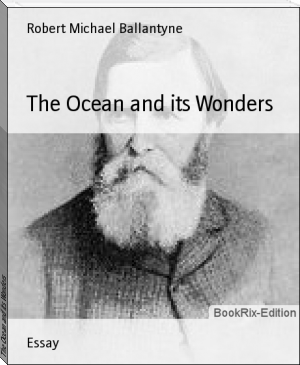The Ocean and its Wonders, Robert Michael Ballantyne [portable ebook reader txt] 📗

- Author: Robert Michael Ballantyne
Book online «The Ocean and its Wonders, Robert Michael Ballantyne [portable ebook reader txt] 📗». Author Robert Michael Ballantyne
The cause of these phenomena is "the reflection of the sun's rays, decomposed by different refractions in minute globules of water, of which the mist, wherein the coronae occur, in a great measure appears to consist."
Mock suns, or _parhelia_, are common appearances in northern skies. Sometimes two of these mock suns are seen, one on each side of their great original, glowing so brightly that either of them, if we could suppose it to have shone in the sky alone, would have made a very respectable sun indeed! Even four of these "sun-dogs"--as they are some times called--have been seen surrounding the sun; one on each side of it, one directly above, and one immediately below, with a ring of light connecting them together, a streak of light passing horizontally and another passing perpendicularly between them, thus forming a luminous cross, in the centre of which was the sun itself. This magnificent spectacle is sometimes enhanced by a second circle of light enclosing the whole, and the edges of several outer circles springing in faint light therefrom until gradually lost, leaving the imagination to call up the idea of an endless series of glories extending over the whole sky.
Refraction frequently causes grotesque as well as wonderful and beautiful appearances. Ships are sometimes seen with their hulls flattened and their masts and sails drawn out to monstrous dimensions; or the hulls are heightened so as to appear like heavy castle walls, while the masts and sails are rendered ludicrously squat and disproportioned; and not only so, but ships are often seen with their images inverted over their own masts, so that to the observer it appears as if one ship were balancing another upside down--mast-head to mast-head. Land and icebergs assume the same curious appearances--peaks touching peaks, one set pointing upwards, the other set pointing down, while the broad bases are elevated in the air. At other times the whole mass of land and ice on the horizon is more or less broken up and scattered about as if in confusion, yet with a certain amount of regularity in the midst of it all, arising from the fact of every object being presented in duplicate, sometimes triplicate, and occasionally, though seldom, four-fold.
When sharp sudden frosts occur in those regions, the splendour of the scenery is still further enhanced by the formation of innumerable minute crystals which sparkle literally with as much lustrous beauty as the diamond. On one occasion Scoresby's ship was decorated with uncommon magnificence, and in a peculiarly interesting manner.
"In the course of the night," he writes, "the rigging of the ship was most splendidly decorated with a fringe of delicate crystals. The general form of these was that of a feather having half of the vane removed. Near the surface of the ropes was first a small direct line of very white particles, constituting the stem or shaft of the feather; and from each of these fibres, in another plane, proceeded a short delicate range of spiculae or rays, discoverable only by the help of a microscope, with which the elegant texture and systematic construction of the feather were completed. Many of these crystals, possessing a perfect arrangement of the different parts corresponding with the shaft, vane, and rachis of a feather, were upwards of an inch in length, and three-fourths of an inch in breadth. Some consisted of a single flake or feather, but many of them gave rise to other feathers, which sprang from the surface of the vane at the usual angle. There seemed to be no limit to the magnitude of these feathers, so long as the producing cause continued to operate, until their weight because so great, or the action of the wind so forcible, that they were broken off and fell in flakes to the deck of the ship."
It is impossible for the mind to conceive the effect of such a galaxy of curious, and bright, and eminently beautiful combinations as are sometimes displayed in the arctic regions. None of the fabulous conceptions of man, even though profoundly elaborated and brightly gilded with the coruscations of the most sparkling genius and fancy, ever produced so gorgeous a spectacle as may be witnessed there every summer day. Four or five suns in the blue sky, with lines and circles of light shooting from or circling round them! Ice in all its quaint, majestic, and shining forms, rendered still more quaint and grand by the influence of refraction; and, by the same power, ships sailing in the sky, sometimes, as if Nature's laws were abrogated, with their keels upwards, and their masts pointing to the sea! Walls of pure ice hundreds of feet high, many miles in extent, clear as crystal, and sending back the rays of heaven's luminaries in broad blazing beams; while the icebergs' pinnacles reflect them in sparkling points! White luminous fogs, like curtains of gauze, too thin to dim the general brightness, yet dense enough to invest the whole scene with a silver robe of mystery, and to refract the light and compel it to shine in great circles of prismatic colours! And everything--from the nature of the materials of which the gay scenery is composed--either white or blue, varying in all gradations from the fairest snow to the deepest azure, save where the rainbow's delicate hues are allowed to intermingle enough of pink, yellow, purple, orange, and green to relieve the eye and enable it more fully to appreciate the virgin drapery of the scene. All this, seen in detail--seen frequently in rapid succession--sometimes seen almost all at one moment,--all this is absolutely beyond conception, and utterly beyond adequate description. Yet all this is seen at times in those realms of ice and snow, which are, as we have already said, too much represented as the "gloomy, forbidding, inhospitable polar regions."
There are two sides to every picture. We take leave of this particular branch of our sun with the remark, that if the shady side of the far north is dreadfully dark and dreary, its bright side is intensely brilliant and beautiful.
CHAPTER FOURTEEN.
ANIMAL LIFE IN THE SEA--MEDUSAE--FOOD OF THE WHALE--PHOSPHORIC LIGHT-- CAUSE THEREOF--LUMINOSITY OF THE OCEAN.
Reference has elsewhere been made in this volume to the immense amount of animal life that exists in the ocean, not only in the form of fish of all sizes, but in that of animalcules, which, although scarcely visible to the naked eye, are, in some cases, so innumerable as to give a distinct colouring to the water.
The _Medusae_, or, more familiarly, sea blubbers, are seen in the waters that lave our own shores. They are of various sizes, from that of a large plate to a pin-head. They are almost colourless, like clear jelly, and when carelessly observed, seem to be dead objects drifting with the tide; but a closer observation shows that they are possessed of life, though not of a particularly active kind, and that they swim by alternate contractions and expansions of their bodies. These creatures constitute a large part of the whale's food. Some of them are flat, some semi-globular, others are bell-shaped, while some have got little heads and small fins. Of these last it is said that each little creature has no fewer than three hundred and sixty thousand minute suckers on its head with which it seizes its prey. When we think of the exceeding smallness of the creatures thus preyed upon, and consider the fact that each little thing must obtain food by making war upon some creatures still smaller than itself, we are led almost in spite of ourselves into that mysteriously metaphysical question--infinitesimal _divisibility_; which may be translated thus--the endless division and subdivision of atoms. This subject has puzzled the heads of the profoundest philosophers of all ages; we will not, therefore, puzzle our readers with it any further.
Scoresby tells us that the colour of the Greenland Sea varies from ultramarine blue to olive-green, from the purest transparency to striking opacity; and that these colours are permanent, and do not depend on the state of the weather, but on the quality of the water. He observed that whales were found in much greater numbers in the green than in the blue water; and he found, on examining the former with the microscope, that its opacity and its colour were due to countless multitudes of those animalcules on which the whale feeds.
We need scarcely remark that it is utterly beyond the power of man to form anything approaching to a correct conception of the amount of _life_ that is thus shown to exist in the ocean. Although it has pleased the Creator to limit our powers, yet it has also pleased him to leave the limit of those powers undefined. We may not, indeed, ever hope in this life to attain to perfect knowledge, nevertheless, by "searching" we may "find out wisdom;" and certain it is, that, although there undoubtedly must be a point of knowledge on any given subject which man cannot reach, there is in man a power incessantly to extend his knowledge and increase his powers of conception, by each successive effort that he makes in his course from the cradle to the grave.
Even although we were told the exact number of the little creatures that inhabit the sea, we could not, by any simple effort of the mind, however powerful, form a conception of what that number implied. We might shut ourselves up like the hermits of old, abstract our thoughts from all other things, and ponder the subject for weeks or months together, and at the termination of our effort we should be as wise as we were at its commencement, but no wiser. But by searching round the subject, and comparing lesser things with greater, although we should still fail to arrive at a full comprehension of the truth, we may advance our powers of conception very considerably beyond the point attained by our first effort; and which point, as we have said, could not be surmounted by a hair's breadth by the mere exertion of simple or abstract thought.
Dr Scoresby's remarks on the subject of animal life in the ocean, are so graphic and curious that we extract the passages verbatim from the admirable memoir of that gentleman, written by his nephew. He says:
"I procured a quantity of snow from a piece of ice





Comments (0)